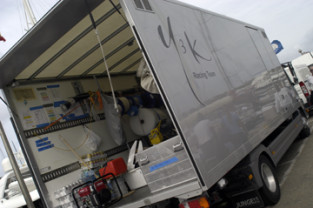Peter Rusch finds out what it takes to keep the Maxi fleet's show on the road
As in Formula 1, the maxi yacht racing circuit takes elite sports teams around the world, in this case chasing glory in glamorous yachting competitions. But keeping a cutting edge, carbon fibre, high-tech maxi yacht in top condition away from home is far from easy.
So each of the elite teams bring their workshops on the road with them, usually in one or two shipping containers dedicated to yacht maintenance. Many of the sailors who regularly crew on the yachts double in a marine trade, be it sailmaking, rigging, hydraulics, carbon fibre work, etc. allowing the teams to fix just about anything that they break out on the race course.
Iain Smith is the logistics manager for Wild Oats , responsible for managing the team, shoreside logistics and moving the boat around the world. On board, when racing, he runs the foredeck. Here he tells us about the shore side set-up for Wild Oats.
We’ve got two 40-foot containers here in the yard?one totally for sails, the other one is a workshop with supplies and spares,” he explains. “We can fix pretty much everything. We’ve got carbon, we’ve got electronic spares and winch spares. We have no trouble with ropes. Any kind of sail repairs, we have guys on board who can handle it. Anything but a catastrophic spar failure or probably the hydraulic ram that cants the keel, if that failed, it would be all over, but we can do most things.”
Smith says Wild Oats has been lucky, not suffering any major failures to date. But the travelling takes its toll.
“The biggest deal that we do is that although the boat is not yet two years old, it’s already been shipped around the world twice,” he says. “So it’s always on and off cranes and ships, in and out of boatyards. It’s a huge logistical thing to manage really.”
Stephan Kessenich has a similar role with the 30.5-metre Wally, Y3K, which has one of the slickest set-ups on display here in Porto Cervo. Its distinctive panel truck is parked on the dock, in front of the boat, filled with spares and tools.

“This truck has some of the racing sails, foul weather gear, rigging, racing equipment and spare parts and tools. It has the stuff we need on-site for if we break something,” Kessenich says.
“We can repair everything on the boat, except I guess a hole in the hull or something like that. But all the running rigging – we have three riggers on the team – so we can do all of that. And all the other technical aspects really. These boats today are so complex with the hydraulics and electronic systems, we have spares for everything and the right guys here, so we don’t need other people really?unless the mast comes down or the boat is holed or something like that!”
Of course, preventing breakages in the first place is a big part of any racing yacht programme. If it never breaks in the first place, you don’t have to fix it.

“Every morning, our bowman goes up the rig with two other guys to do a complete mast check,” Kessenich says. “They look at every screw, every fitting, the entire rig. Our riggers check every line for damage on the splice or shackle or something. Our trimmers check the sails and make sure any repair that has been made has been done properly. They know from sailing the previous day what they need to look at. We can hand-stitch or put ‘stickyback’ on any problem areas.”
On a day like today, when the Mistral wind is gusting over 40-knots, it is this type of maintenance that breeds confidence that these cutting edge racing machines would make it around the race course intact. Of course, if you can’t get off the dock because of the wind, that’s another story?and, if nothing else, more time for maintenance.
PODCAST – CLICK HERE to listen to Iain Smith talk to Peter Rusch



